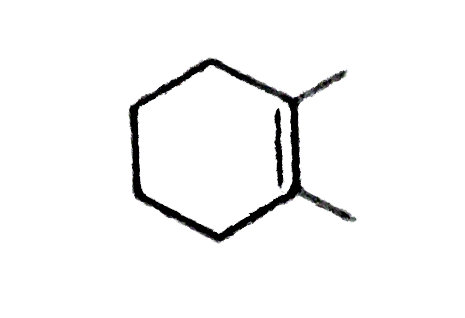Assertion (A) The α-hydrogen atom in carbonyl compounds is less acidic.
Reason (R) The anion formed after the loss of α-hydrogen atom is resonance stabilised.
The correct Answer is:d
To analyze the assertion and reason provided in the question, we can break down the concepts step by step.
Step 1: Understand the Assertion
The assertion states that "the alpha-hydrogen atom in carbonyl compounds is less acidic." This means that the alpha-hydrogen is not likely to donate a proton (H⁺) easily.
Hint: Remember that acidity is determined by how easily a hydrogen atom can be removed as a proton.
Step 2: Analyze the Reason
The reason given is that "the anion formed after the loss of alpha-hydrogen atom is resonance stabilized." This implies that when the alpha-hydrogen is removed, the resulting anion (conjugate base) is stabilized by resonance.
Hint: Consider how resonance stabilization affects the stability of anions and their propensity to form.
Step 3: Evaluate the Acidity of Alpha-Hydrogens
In carbonyl compounds (like aldehydes and ketones), the alpha-hydrogens are indeed acidic. When a strong base is introduced, it can abstract the alpha-hydrogen, leading to the formation of a resonance-stabilized anion. This stabilization makes the loss of the alpha-hydrogen more favorable, indicating that the alpha-hydrogens are, in fact, more acidic.
Hint: Think about the stability of the conjugate base formed after deprotonation and how resonance contributes to that stability.
Step 4: Conclusion
Based on the analysis:
- The assertion is incorrect because alpha-hydrogens in carbonyl compounds are more acidic, not less.
- The reason is correct because the anion formed after the loss of alpha-hydrogen is indeed resonance stabilized.
Thus, the correct conclusion is that the assertion is false, while the reason is true.
Final Answer: The assertion (A) is incorrect, and the reason (R) is correct. Therefore, the correct option is that the assertion is wrong, but the reason is correct.
The assertion states that "the alpha-hydrogen atom in carbonyl compounds is less acidic." This means that the alpha-hydrogen is not likely to donate a proton (H⁺) easily.
The reason given is that "the anion formed after the loss of alpha-hydrogen atom is resonance stabilized." This implies that when the alpha-hydrogen is removed, the resulting anion (conjugate base) is stabilized by resonance.
In carbonyl compounds (like aldehydes and ketones), the alpha-hydrogens are indeed acidic. When a strong base is introduced, it can abstract the alpha-hydrogen, leading to the formation of a resonance-stabilized anion. This stabilization makes the loss of the alpha-hydrogen more favorable, indicating that the alpha-hydrogens are, in fact, more acidic.
Based on the analysis:
- The assertion is incorrect because alpha-hydrogens in carbonyl compounds are more acidic, not less.
- The reason is correct because the anion formed after the loss of alpha-hydrogen is indeed resonance stabilized.
Topper's Solved these Questions
- BOOK - NCERT EXEMPLAR ENGLISHCHAPTER - ALDEHYDE, KETONES AND CARBOXYLIC ACIDSEXERCISE - Long Answer Type Questions4videos
ALDEHYDE, KETONES AND CARBOXYLIC ACIDS
- BOOK - NCERT EXEMPLAR ENGLISHCHAPTER - ALDEHYDE, KETONES AND CARBOXYLIC ACIDSEXERCISE - Long Answer Type Questions4videos
ALDEHYDE, KETONES AND CARBOXYLIC ACIDS
- BOOK - NCERT EXEMPLAR ENGLISHCHAPTER - ALCOHOLS, PHENOLS AND ETHERSEXERCISE - All Questions74videos
ALCOHOLS, PHENOLS AND ETHERS
- BOOK - NCERT EXEMPLAR ENGLISHCHAPTER - AMINESEXERCISE - LONG ANSWER3videos
AMINES
Similar Questions
Knowledge Check
- Question 1 - Select One
Assertion : β- hydrogen atom of carbonyl compounds is acidic in nature.
Reason : β- hydrogen is directly attached to carbon next to carbonyl carbon.AIf both assertion and reason are true and reason is the correct explanation of assertion.BIf both assertion and reason are true but reason is not the correct explanation of assertion.CIf assertion is true but reason is false.DIf both assertion and reason are false. - Question 2 - Select One
The most acidic hydrogen atoms are present in
AEthaneBetheneCethyneDbenzene - Question 3 - Select One

Sum of number of α- hydrogen present is compound A + B is :A18B19C20D21
The number of hyperconjuable hydrogen atom in the compound is :
 View Solution
View SolutionHydrogen generally form covalent compounds. Give reason
View SolutionAssertion (A) Boiling points of alcohols and ethers are high.
Reason (R) They can form intermolecular hydrogen-bonding.View SolutionAssertion: Esters which contain α−hydrogens undergo Claisen condensation.
Reason : LiAIH4 reduction of esters gives acidsView SolutionNumber of acidic hydrogen atoms in but-1-yne is
View Solution


